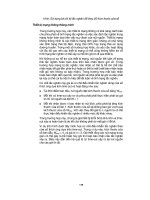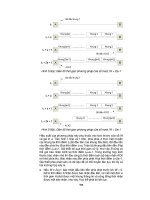SEXTANT HÀNG HẢI VÀ CÁC SAI SỐ
Bạn đang xem bản rút gọn của tài liệu. Xem và tải ngay bản đầy đủ của tài liệu tại đây (4.34 MB, 42 trang )
The Sextant
What it is and how it works.
The parts of a Sextant
What is a Sextant?
A sextant is a measuring instrument generally
used to measure the angle of elevation of a
celestial object above the horizon.
Making this measurement is known as sighting
the object, shooting the object or taking a sight.
The angle, and the time when it was measured,
can be used to calculate a position line on a
nautical chart.
What is a Sextant?
Held horizontally, the sextant can be
used to measure the angle between any
two objects, such as between two
lighthouses, which will also allow for
calculation of a line of position on a
chart.
What is a Sextant?
The scale of a sextant has a length of 1⁄6th. of
a full circle (60°); hence the sextant's name
(sextāns, -antis is the Latin word for "one
sixth").
An octant is a similar device with a shorter
scale (1⁄8 of a circle, or 45°),
A quintant (1⁄5, or 72°)
A quadrant (1⁄4, or 90°)
An Octant
A Quintant
How to handle a Sextant
• Please remember, especially for MCA ‘Orals’
examinations that the Sextant is a delicate
instrument and must be handled in a particular
manner
• MCA examiners will be looking for this if they
ask you questions relating to the Sextant
The Principle of the Sextant
• When a ray of light
is reflected twice in
the same plane by
two mirrors……
• the angle between
the first and last
directions of the ray
• is twice the angle
between the
mirrors.
A Sextant at Work
First Error = Perpendicularity:The index mirror must be perpendicular to the
plane of the instrument
To find out if this error is present , set the index bar near the
middle of the arc
Hold the sextant horizontally with the arc away from you.
View the true arc, and also the reflected arc in the index
mirror.
Perpendicularity:The true & reflected arcs should appear as one
unbroken & continuous line
Correct any error by means of the first adjustment screw (1)
on the back of the Index morror
What you should see
What you should NOT
see
What you should NOT
see
Second Error = Side Error :The horizon mirror must be perpendicular to the plane
of the instrument
There are two methods by which it can be determined if this
error is present:Star Method
AND
Horizon Method
Side Error (continued):Using the Star method
Set the sextant to zero
Hold the sextant vertically and view a well defined star
through the eyepiece
The true and reflected images should be in the same vertical
plane
Side Error (continued):Using the Star method
This is what should be seen
when no side error exists
If it does exist, this is what
will be seen
Side Error (continued):Using the Horizon method
Set the sextant to zero
Hold the sextant near to horizontal and view a well defined
section of the horizon through the eyepiece
The true and reflected images should be in the same
continuous line
Side Error (continued):Using the Horizon method
This is what should be seen
when no side error exists
If it does exist, this is what
will be seen
Side Error (continued):This error is corrected by using the
2nd. adjustment screw on the
horizon mirror
2
3
The 2nd. adjustment screw is
furthest from the plane of the
instrument









